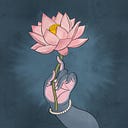Hanumān as Āyurveda Svarūpa
“lāya sa̐jīvani lakhana jiyāye
śrīraghubīra haraṣi ura lāye”
“Bringing the Mṛtasañjīvanī herb, You resuscitated Lakṣmaṇa. The auspicious Lord Rāma rejoiced and embraced You.” (Hanumān Cālīsa)
Hanumān is venerated as Āyurveda Svarūpa in reference to his quest for the rare Himalayan herb Mṛtasañjīvanī that heals all wounds. It is a sort of mini-epic that lends immense heroism and inspires worship of Hanumān as the bearer of the rejuvenating medicine. The tale is significantly elaborated in most medieval retellings of the Rāmāyaṇa, such as in the Telugu Raṅganātha Rāmāyaṇa, the Bengali Krittibasa’s Rāmāyaṇa or the Śrīrām Pãcālī, and in the Adhyātma Rāmāyaṇa. Though Hanumān is the foremost among the wise — jñāninām agragaṇyam — in Tulsidas’ words, the herbs ‘‘hide’’ themselves from Hanuman, prompting him to lift the entire mountain and brings it to the battlefield where the rākṣasa physician Suṣena administers the herb and heals Rāma and Lakṣmaṇa.
“When the arrow pierced Lakshmana’s breast
his vital breath departed, struck by Rāvaṇa’s son.
You brought physician Suṣena along with his house,
then, O Hero, you transported the Drona mountain
and came, giving the sañjīvana herb with your own hand,
thus you saved Lakṣmaṇa’s life.
Who in the world doesn’t know, Monkey,
that your name is Saṅkaṭ Mōcan?”
(Saṅkaṭ Mōcan Aṣṭaka)
After bringing the Mṛtasañjīvanī from the Droṇa mountain in the Himālayas that rejuvenates Lakṣmaṇa, Hanumān experiences the auspicious embrace of Lord Rāma.
Tulasīdāsa says:
“haraṣi rāma bhe̐ṭeu hanumānā
ati-kṛtajña prabhu parama sujānā”
“Lord Rāma, who is extremely grateful and supremely knowledgeable (omniscient), rejoiced and embraced Hanumān.”
The link between Hanumān, the son of the wind god and Āyurveda is also reflected in the role of Vāyu in both body and cosmos in traditional āyurvedic texts. Numerous bodily illnesses are believed to result from an imbalance of vāyu, one of the three principal humors. An ‘‘excess of wind’’ (vāta prakopa) results in gout, epilepsy, and rheumatism (vāta-roga or ‘‘wind disease”) and a person with mental illness is said to be ‘‘windy’’ (Sanskrit vātūla). Both mental and physical illnesses that arise as a result of various spirits (bhūta, preta, piśāca) that reside in the air are said to obey the commands of the lord of the Marut winds, and hence Hanumān is often worshipped as the eradicator of such illnesses. This terminology employed in āyurveda is also tied to yogic philosophy, wherein the element of macrocosmic ‘‘wind’’ is understood as identical with the microcosmic ‘‘five breaths’’ (pañca prāṇa) that sustain life.
References:
- Hanuman’s tale by Philip Lutgendorf
2. Mahaviri by Nityanand Misra
______________________________________________________________
If you find value in my work, I hope you consider becoming a patron through Patreon. Hindu Aesthetic requires a lot of time and effort and your support would mean that I can continue bringing you the highest quality content. Link to my Patreon:
